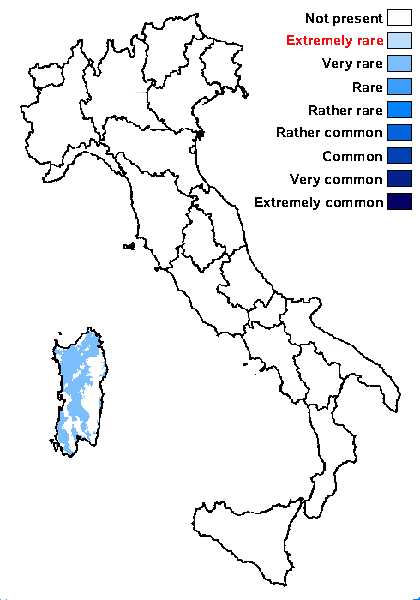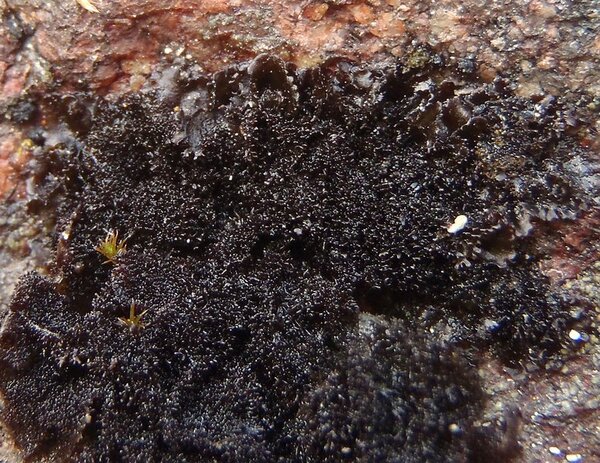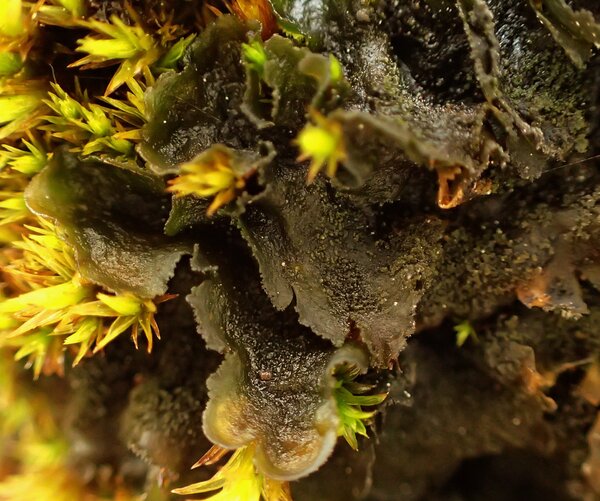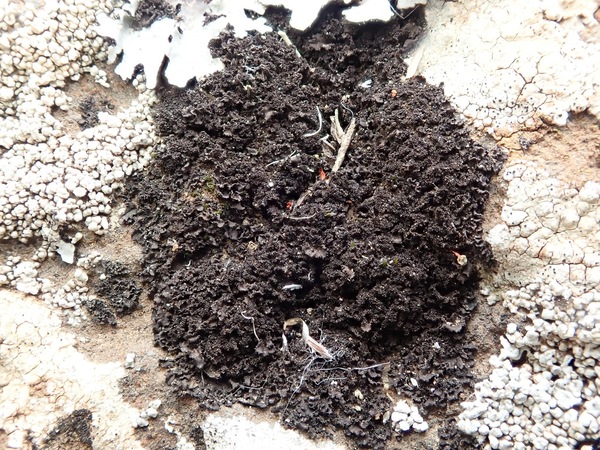Scytinium subaridum (P.M. Jørg. & Goward) Otálora, P.M. Jørg. & Wedin
Fungal Divers., 64, 1: 291, 2013. Basionym: Leptogium subaridum P.M. Jørg. & Goward - Acta Bot. Fenn., 150: 76, 1994.
Synonyms:
Distribution: C - Sar (Aragon & al. 2004).
Description: Thallus minutely foliose, subgelatinous when wet, 100-150 μm thick, forming 1-3 cm wide patches. Lobes rounded to elongate, entire or lobulate, toothed, 1-3 mm wide, smooth to partially finely striate, dark brown to dark greenish brown, with laminal and marginal, clavate to dactyliform, concolorous but apically darker isidia. Lower surface paler than the upper surface, without tomentum. Upper and lower cortex paraplectenchymatous, composed of a single layer of angular cells, the layer inbetween with loosely interwoven chains of Nostoc and hyphae. Apothecia very rare, lecanorine, 0.5-1 mm across, laminal, shortly pedicellate, with a concave, brownish disc and a distinct, isidiate thalline margin. Thalline exciple 20-45 µm wide, corticate; proper exciple euparaplectenchymatous, 20-50 µm wide; epithecium brownish; hymenium colourless, 100-135 µm high, I+ blue; paraphyses mostly simple, c. 2 µm thick at mid-level, the apical cells 3-3.5 µm wide, with external brown pigmentation; hypothecium colourless, 25-40 µm high, of closely compacted hyphae, I+ blue. Asci 8-spored, narrowly clavate, the apex strongly thickened, the apical dome K/I+ pale blue, with a downwardly projecting K/I+ deep blue tubular structure. Ascospores muriform, hyaline, ellipsoid, 23-30 x 9-12 µm. Photobiont cyanobacterial (Nostoc, the cells in long chains). Spot tests: all negative. Chemistry: without lichen substances. Note: a Mediterranean to mild-temperate lichen known from North America, found on the base of old trees, more rarely on schists. According to Jørgensen (in litt.), however, the presence of this species in Europe is dubious. It is included in the Italian red list of epiphytic lichens as “Data Deficient” (Nascimbene & al. 2013c).
Growth form: Squamulose
Substrata: bark and rocks
Photobiont: cyanobacteria, filamentous (e.g. Nostoc, Scytonema)
Reproductive strategy: mainly sexual
Poorly known taxon in need of further study
Commonnes-rarity: (info)
Alpine belt: absent
Subalpine belt: absent
Oromediterranean belt: absent
Montane belt: absent
Submediterranean belt: absent
Padanian area: absent
Humid submediterranean belt: very rare
Humid mediterranean belt: absent
Dry mediterranean belt: very rare

Predictive model


Curtis Randall Björk – CC BY-SA 4.0
British Columbia, Clearwater Valley, Third Canyon Uplands Date: 2012-05-04 On calc-modified metamorphic rock in canyon, south facing, open, by creek
Growth form: Squamulose
Substrata: bark and rocks
Photobiont: cyanobacteria, filamentous (e.g. Nostoc, Scytonema)
Reproductive strategy: mainly sexual
Poorly known taxon in need of further study
Commonnes-rarity: (info)
Alpine belt: absent
Subalpine belt: absent
Oromediterranean belt: absent
Montane belt: absent
Submediterranean belt: absent
Padanian area: absent
Humid submediterranean belt: very rare
Humid mediterranean belt: absent
Dry mediterranean belt: very rare

Predictive model


 Index Fungorum
Index Fungorum
 GBIF
GBIF




